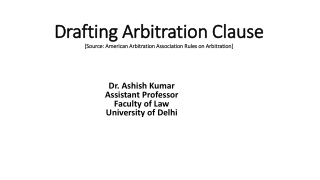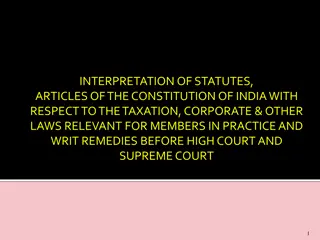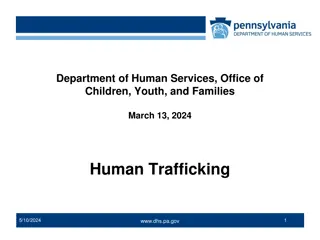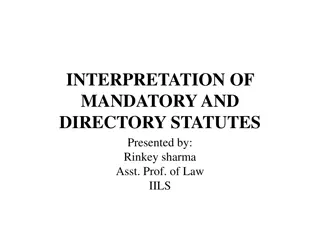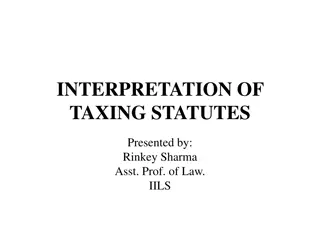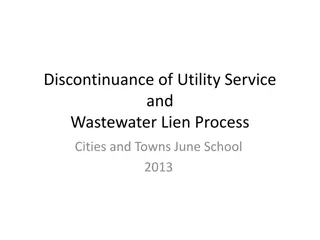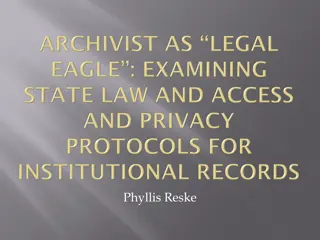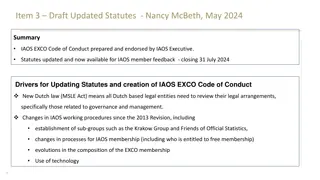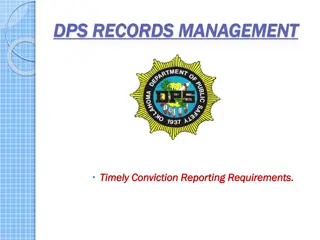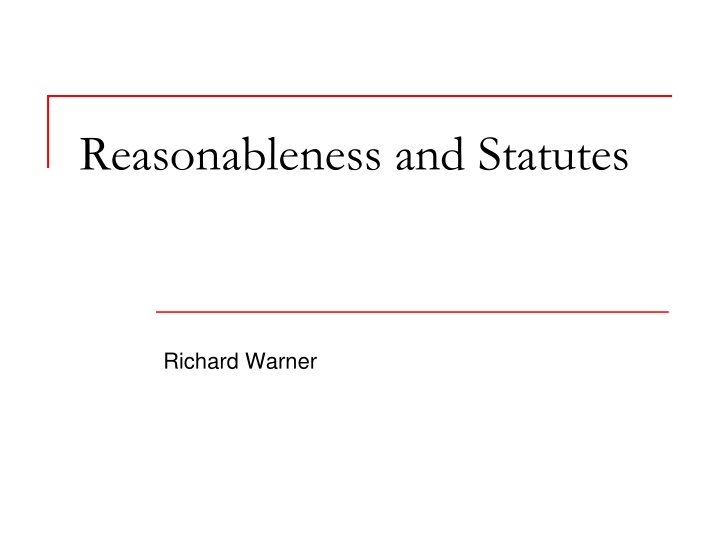
Reasonableness and Statutory Requirements for Data Security
Explore the importance of reasonableness and specific requirements in safeguarding electronic protected health information under statutes like the HIPAA Security Rule. Understand the pros and cons of specific requirements versus reasonableness in maintaining data security.
Download Presentation

Please find below an Image/Link to download the presentation.
The content on the website is provided AS IS for your information and personal use only. It may not be sold, licensed, or shared on other websites without obtaining consent from the author. If you encounter any issues during the download, it is possible that the publisher has removed the file from their server.
You are allowed to download the files provided on this website for personal or commercial use, subject to the condition that they are used lawfully. All files are the property of their respective owners.
The content on the website is provided AS IS for your information and personal use only. It may not be sold, licensed, or shared on other websites without obtaining consent from the author.
E N D
Presentation Transcript
Reasonableness and Statutes Richard Warner
Reasonableness Cost/benefit custom and practice Industry standard Statutory requirements
Reasonableness Versus Specific Requirements. Reasonableness requirements simply require reasonable safeguards against unauthorized access. Alternatively, one can identify specific requirements that must be implemented. Statutes take one approach or another or combine them.
The HIPAA Security Rule, 45 CFR 164.306 (a) and (b) a) General requirements. Covered entities and business associates must do the following: (1) Ensure the confidentiality, integrity, and availability of all electronic protected health information the covered entity or business associate creates, receives, maintains, or transmits. (2) Protect against any reasonably anticipated threats or hazards to the security or integrity of such information .
HIPAA Security Rule, 45 CFR 164.306 (c) and (e) (c) Standards. A covered entity or business associate must comply with the applicable standards as provided in this section and in 164.308, 164.310, 164.312, 164.314 and 164.316 with respect to all electronic protected health information. (e) Maintenance. A covered entity or business associate must review and modify the security measures implemented under this subpart as needed to continue provision of reasonable and appropriate protection of electronic protected health information, and update documentation of such security measures in accordance with 164.316(b)(2)(iii).
164.308 Administrative safeguards. (a) A covered entity or business associate must, in accordance with 164.306: (1) (i) Standard: Security management process. Implement policies and procedures to prevent, detect, contain, and correct security violations. (ii) Implementation specifications: (A) Risk analysis (Required). Conduct an accurate and thorough assessment of the potential risks and vulnerabilities to the confidentiality, integrity, and availability of electronic protected health information held by the covered entity or business associate.
Specific Requirements: Pros and Cons Pro: Predictability: you know what is required. Possibly, greater expertise. Con: May easily become out of date. May not be flexible. May not require enough (agency capture).
Reasonableness Our discussion uses the notion of expected gain and loss. The idea is familiar from everyday life. Suppose that, on Monday, you want to go to dine on Brazilian food much more than you want to eat Mediterranean fare, but you go to the Mediterranean anyway. Why?
The Explanation You think it highly likely that the Brazilian restaurant is closed on Mondays while you are virtually certain the Mediterranean is open. When you take the probability of being open into account, the expected gain of going to the Mediterranean restaurant makes going there a more attractive option than expected loss of going to the almost certainly closed Brazilian restaurant.
What Is The Required Level Of Care In Kline? The landlord in Kline underinvested in security. How should a landlord decide how much to invest? Our answer is that they should decide in a way analogous to the way you decided whether to go the Brazilian or Mediterranean restaurant. Imagine a landlord Alissa deciding how much to invest to upgrade her current defenses.
Expected Harm From Current Defenses Assume that she knows the probability for months of different types of attacks in the common areas given her current defenses, and the amount of harm each type of attack causes. That allows her to determine the expected harm from attacks given her current defenses: Expected harm from current defenses = harm from attacks taking probability into account.
Reduced Expected Harm From Current Defenses Next assume she knows the various possible improvements in defense available. The improvements do not ensure that there will never be an attack in the common areas, but they reduce the probability of an attack. For any improvement, assume Alissa knows the new, reduced probability of attacks. Then she can determine the reduction in expected harm from adopting an improvement: reduced expected harm from current defenses = harm from attacks taking reduced probability into account.
Knowledge Of Costs Finally, assume Alice knows how much the various possible improvements cost. Costs here include not just Alissa s time, effort, and money, but also the costs to tenants, such as increased rent as Alissa passes her increased costs on to her tenants and a loss of privacy from increased security surveillance from security personal and video cameras. Then we have an answer to how much she should invest in security.
The Right Level of Investment She should keep investing to reduce the expected harm until any further investment would spend more on security than the expected harm it avoids. Investing less is wasteful because a large investment would cost less than the harm it avoids. Investing more is also wasteful because the investment is great than the harm it avoids.
Do Landlords Know What They Need To Know? Assume a landlord should decide how much to invest in security based on an expected gain and loss analysis. Will they know what they need to know? Will they know how much harm different types of attacks cause? Will they know the probability of an attack before and after improvements in defenses? Landlords are unlikely to have access to the necessary statistical studies if indeed such studies exist.
When Do We Know? Yes No Doubtful Cybersecurity Your restaurant choice The T. J. Hooper Driving under normal conditions Hadley v. Baxendale Wagon Mound cases Landlord/tenant in Kline
Industry Standards The majority s answer is that landlords can find evidence of the degree of security required in the security practices of other landlords in similar buildings. As the majority says the required level of protection is the standard of protection commonly provided in apartments of this character and type in this community.
Market Assumptions It makes sense to treat industry practice as evidence of reasonableness if renters can know the different degrees of protection different landlords offer, and if they avoid landlords who underinvest in security (landlords who ought to reduce expected harms by spending more), and rent instead from landlords who adequately invest (invest until any further investment would spend more on security than the expected harm it avoids). Then profit-driven landlords have an incentive to offer security/rent combinations renters see as acceptable. Do you think renters behave this way? A similar Do defenders know what they need to know? question arises for cybersecurity and is even more problematic to answer.
Data Breach Notification Laws The laws require companies to publicly report data breaches. Three reasons: One, politically very popular. Two, it provides some statistics to security researchers about costs and probabilities. And three, it forces companies to improve their security. At least many claim so.
Doubts About Improvement Data breach notification laws create an incentive to avoid breach reporting costs. The laws define the type of event a business must report. So they create an incentive to reduce reportable data breaches. They do not create an incentive to improve security in regard to problems that do not manifest themselves as reportable data breaches.
Private Rights of Action Capital One Capital One on AWS - server can copy information from and to a URL Data on the hackers website Hackers gain access through a misconfigured firewall = Capital One left the door open Hackers tell the server to send data to a URL the hacker control -- this is the SSFR.
Virginias Breach Notification Statute Breach of the security = unauthorized access and acquisition of unencrypted and unredacted computerized data that compromises the security or confidentiality of personal information . . . that causes, or the individual or entity reasonably believes has caused, or will cause, identity theft or other fraud.
The Private Right of Action An individual may recover economic damages from a violation of this section.
Overview Unauthorized access Virginia statute Breach of confidence Positive act of disclosure Negligence Unreasonableness Litigation is expensive. A simple law suit will cost at least $10,000. Complex litigation will cost much much more. Will governments take over the burden of suing?



